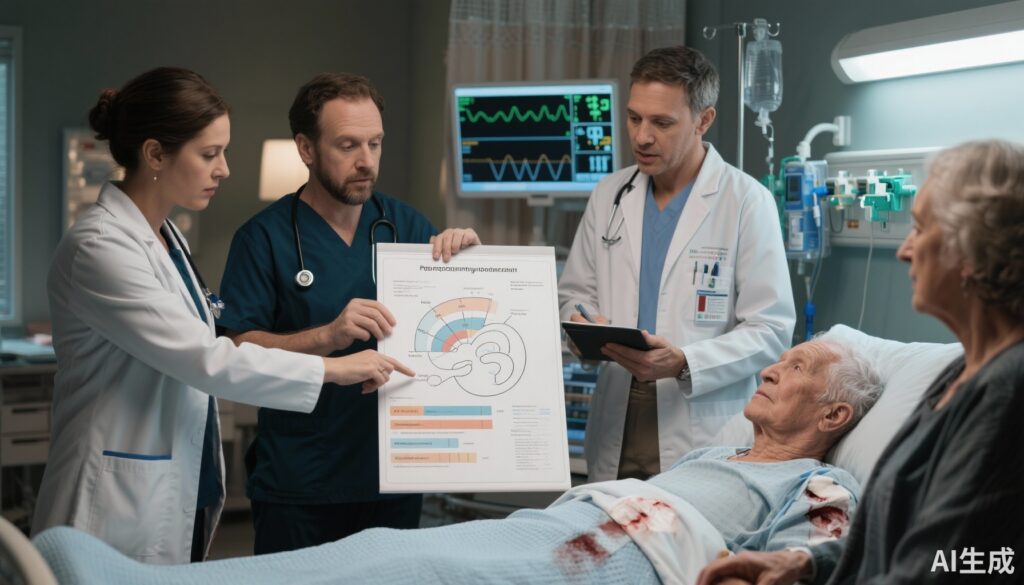ハイライト
Best Case/Worst Case-ICU (BC/WC-ICU) コミュニケーションツールは、外傷ICUの医療従事者と家族間で構造化され、一貫性のある予後討論を可能にします。
米国の8つの大規模な外傷センターでの実装により、高い医師の遵守率と効果的な家族へのリーチが確認されました。
競合する臨床要件、コミュニケーションの不快感、革新への疑問などの障壁が長期的な維持に影響を与えます。
BC/WC-ICUの効果的な使用は、医療従事者の道徳的ストレスを軽減し、家族による意思決定の一貫性をサポートします。
研究の背景と疾患負荷
外傷集中治療室(ICU)では、特に深刻な怪我を負った高齢者をケアする際、健康状態と機能状態が急速かつ著しく変化するため、複雑なコミュニケーション課題が生じます。この状況での最適な意思決定には、予後の明確な理解が必要であり、医師、患者、家族間のケア目標を一致させる必要があります。しかし、医師は予後の不確実さやコミュニケーションの障壁に苦労することが多く、これが一貫性のないメッセージング、家族のストレス、提供者の中の道徳的ストレスにつながることがあります。
重篤なケア環境向けにカスタマイズされた高度なコミュニケーションツールは、これらの討論を支援するために不可欠です。Best Case/Worst Case (BC/WC) フレームワークは、手術の意思決定のために開発されたもので、ICU(BC/WC-ICU)での使用に適応され、グラフィックエイドを使用して可能な結果の範囲を示すことで、毎日の構造化された予後会話を促進し、討論の明確さと共感を向上させます。これまでのところ、外傷ICUでの実装に関する証拠は限られています。
研究デザイン
この品質改善研究は、米国の8つの大規模な外傷センターで行われた多施設ランダム化臨床試験の枠組み内で実施されました。研究期間は2023年10月から2025年1月まででした。各機関は順次実装フェーズに参加し、3ヶ月間の集中的な実装トレーニングフェーズが行われ、外傷チームメンバー(アテンディング医師、フェロー、レジデント、高度な実践プロバイダー、ベッドサイド看護師)にBC/WC-ICUツールについて教育が行われました。
介入は、毎日の臨床ラウンド中にBC/WC-ICUツールを使用することでした。これには、過去24時間で起こった主要な出来事のチーム討論と、患者の回復の最良シナリオと最悪シナリオの作成が含まれ、これらは標準化されたグラフィックエイドに注釈付けられました。その後、医師はグラフィックエイドを使用して患者の家族に予後を伝え、共有理解と意思決定を促進しました。
実装結果は、Reach, Effectiveness, Adoption, Implementation, and Maintenance (RE-AIM) フレームワークを通じて評価され、浸透度、有用性、遵守率、忠実度、持続性が評価されました。
主な知見
合計208人の外傷外科医、集中治療医、フェローが個別の一対一のBC/WC-ICUトレーニングセッションを完了しました。研究期間中、約1300件の患者・家族との遭遇でツールが使用され、広範なリーチが示されました。
医師は、BC/WC-ICUが家族をサポートし、予後の一貫したメッセージングを提供することで、下流の意思決定を改善し、ケアチームが経験する道徳的ストレスを和らげることを報告しました。グラフィックエイドの使用の忠実度は高く、各サイトの平均スコアは8点満点で6.22から7.12の範囲でした。これはツールの正確で一貫した使用を示しています。
BC/WC-ICU介入の遵守率はサイトによって異なり、平均遵守率は45%(SD 30.4)から100%(SD 0)の範囲でした。完全な実装を妨げる要因には、競合する臨床タスクの要求、予後の討論に対する医師の恐怖や不快感、ツールの使用方法の誤解、BC/WC-ICUが新規性や追加的な有用性に欠けるという認識が含まれ、採用に対する懐疑論を引き起こしました。
持続性に関しては、トレーニング後12ヶ月の長期維持はほとんどのセンターで制限されており、1つの外傷センターのみが日常の業務に継続的に統合されていることが示され、ツールをルーチンワークフローに組み込むことの難しさが示唆されました。
専門家のコメント
この研究は、予後の不確実さと迅速な臨床変化が一般的な高急性、高速な外傷ICU環境で、BC/WC-ICUのような構造化されたコミュニケーション戦略の実現可能性と利点を強調しています。
最良と最悪の回復シナリオを中心に討論を行うことで、ツールは透明性と患者・家族のエンゲージメントを向上させ、倫理的に整合性のあるケアにとって重要です。グラフィックエイドはさらに、理解と記憶を向上させる具体的なコミュニケーションエイドとして機能します。
しかし、この介入の成功は、組織文化、医師の態度、運用上の統合に大きく依存します。作業負荷の圧力や予後を議論することへの抵抗は、継続的なサポート、訓練の強化、および指導者の承認の必要性を強調しています。
ツールに関する誤解を解消し、その証拠に基づく利点を明確に伝えることで、躊躇を克服することが重要です。今後の研究では、BC/WC-ICUをデジタルエイドと組み合わせたり、電子健康記録に統合したりすることで、使用を合理化する方法を探るかもしれません。
制限には、サイト間の遵守率の変動と、意思決定の質を超えた患者・家族のアウトカムの欠如が含まれます。これらは全体的な影響を評価する上で重要です。
結論
BC/WC-ICUコミュニケーションツールは、外傷ICUチームが患者と家族との有意義な予後討論を行い、意思決定をサポートし、医師の道徳的ストレスを軽減するための有望な進歩を代表しています。
成功した実装には、競合する要件に対処し、コミュニケーションを高品質な重篤ケアの一部として重視する文化的な環境を育成する包括的なトレーニングが必要です。継続的な使用には、ツールを臨床ワークフローに組み込むための対策と継続的な品質改善サイクルが有益であるかもしれません。
今後の研究では、採用を向上させる戦略、患者中心のアウトカムへの影響を調査し、異なるケア設定にツールを適応させてその臨床的有用性を最大化する方法を探るべきです。
参考文献
Fritz ML, Hernandez AH, Zelenski AB, Nitkowski J, Sobol C, Kwekkeboom K, Bradley T, Tsang J, Bushaw K, Dudek A, Stalter L, Schwarze ML. Best Case/Worst Case Communication Tool for Trauma Intensive Care Units. JAMA Surg. 2025 Sep 24:e253782. doi: 10.1001/jamasurg.2025.3782. Epub ahead of print. PMID: 40991261; PMCID: PMC12461598.


